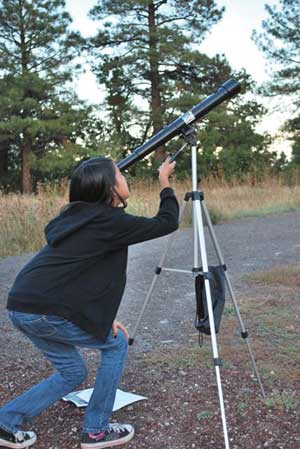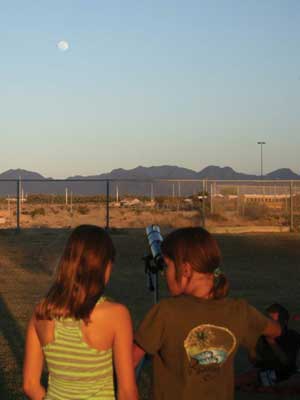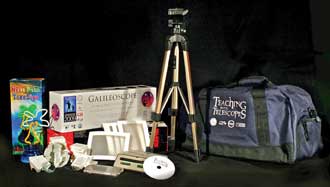Thanks to its ability to increase interest in STEM subjects while promoting deeper understanding of the material, active learning was front and center in many of the sessions at ETOP 2013, the 12th International Conference on Education and Training in Optics and Photonics. The conference was held July 23-26 at the University of Porto in Portugal and brought together more than 210 participants from 36 countries to discuss and demonstrate new developments in the field as well as novel approaches to teaching and learning.
Theodore Hodapp, director of education and diversity for the American Physical Society, kicked off the conference with an invited talk on issues facing physics in the US, including low participation of women and some racial/ethnic groups, and poorly trained secondary school teachers.
The standard method of teaching introductory physics often reinforces dislike of the subject, Hodapp pointed out. Teachers need to use proven pedagogy based on physics education research, he said – for example, the “flipped classroom,” where “lecture” (through online videos and simulations) and homework are done outside of class, and students spend class time working in teams, guided by an instructor who acts as mentor and facilitator. Rigorous studies have shown such pedagogies improve student problem-solving ability and conceptual understanding of material while increasing student retention in physics as well.
 Several conference sessions were devoted to projects that aim to increase optics/photonics awareness at the elementary- and middle-school levels. Many projects are successful because of a strong industry component, with companies providing mentors, tours, technical advice, financial support and outreach volunteers. One such effort is the Galileoscope project. One of the project’s leaders, Stephen Pompea of the National Optical Astronomy Observatory (NOAO) in Tucson, Ariz., led a workshop on using this inexpensive and innovative telescope kit to teach concepts in optics.
Several conference sessions were devoted to projects that aim to increase optics/photonics awareness at the elementary- and middle-school levels. Many projects are successful because of a strong industry component, with companies providing mentors, tours, technical advice, financial support and outreach volunteers. One such effort is the Galileoscope project. One of the project’s leaders, Stephen Pompea of the National Optical Astronomy Observatory (NOAO) in Tucson, Ariz., led a workshop on using this inexpensive and innovative telescope kit to teach concepts in optics.
Teamwork leads to better telescope
The project has roots in Harnessing Light, the 1998 US National Research Council study. The committee identified the need for innovation in optics education to address critical national needs for optics and photonics technicians, scientists and engineers. Harnessing Light led to the National Science Foundation-sponsored education project called Hands-On Optics (HOO), a four-year SPIE, OSA and NOAO project. HOO designed and disseminated educational materials for middle-school students in after-school and museum settings, and reached more than 20,000 students. The project relied heavily on industry resource volunteers, often retired professionals who provided subject-matter expertise to educators at HOO locations across the country. Many HOO optics activities grew from the work of the Arizona Optics Industry Association, which supports 250 companies in the Arizona photonics cluster.
Although HOO’s telescope module was very popular with students and industry volunteers, it used a primitive cardboard telescope suitable only for daytime use. The Galileoscope effort was born as a worldwide cornerstone project to create a new high-quality, low-cost telescope kit for students. The project was timed so that the new telescope could be used during the International Year of Astronomy in 2009, celebrating the 400th anniversary of Galileo’s use of the telescope.
 Relying on volunteer efforts, the project to create the optical and mechanical design for the new telescope was spearheaded by Pompea, Rick Fienberg of the American Astronomical Society and Doug Arion of Carthage College. Fienberg and Arion brought extensive experience in business and manufacturing to the project. The Telescope Kits Working Group included engineers from aerospace companies as well as optical designers and experts on science education. Many of the volunteers recognized that their own interest in optics was fueled by using a telescope as a child.
Relying on volunteer efforts, the project to create the optical and mechanical design for the new telescope was spearheaded by Pompea, Rick Fienberg of the American Astronomical Society and Doug Arion of Carthage College. Fienberg and Arion brought extensive experience in business and manufacturing to the project. The Telescope Kits Working Group included engineers from aerospace companies as well as optical designers and experts on science education. Many of the volunteers recognized that their own interest in optics was fueled by using a telescope as a child.
The working group systematically analyzed the problem of creating a better telescope that could still be delivered at low cost. Analysis of the previous cardboard tube telescope by optical engineers at Photon Engineering LLC in Tucson showed that a much higher quality telescope with good stray-light performance for city use and excellent eye relief could be designed using a Plössl eyepiece. This final telescope design, produced by Scott Ellis and Richard Pfisterer of Photon Engineering, became the Galileoscope.
The educational materials created for the Galileoscope rely greatly on HOO materials and were created to expose students to active investigations of complex problems, similar to what they might encounter in more open-ended industry situations. The optical quality is such that the rings of Saturn, the Galilean satellites of Jupiter, the Andromeda Galaxy and stunning views of the moon are visible. Unlike the usual low-end department-store telescope, the Galileoscope also provides the fun of building the device and seeing how the lenses go together to produce an image.
 To support educational efforts using Galileoscopes, many technology-based companies are buying large numbers for local schools and then using online educational materials for training and implementation. The companies are also relying on employees who are amateur astronomers to assist the schools. For example, in Tucson, Raytheon sponsors several hundred students each year in building and using Galileoscopes.
To support educational efforts using Galileoscopes, many technology-based companies are buying large numbers for local schools and then using online educational materials for training and implementation. The companies are also relying on employees who are amateur astronomers to assist the schools. For example, in Tucson, Raytheon sponsors several hundred students each year in building and using Galileoscopes.
Constructing a telescope is an exciting way to learn about optics, and the optics/photonics societies have also provided many kits to student chapters and others who work with children. SPIE has donated more than 250 Galileoscopes to its student chapters around the world for regional outreach, and the OSA Foundation has donated 5500 kits to students in 37 countries through its Galileoscope Challenge, impacting at least 28,000 young minds. In all, over 200,000 Galileoscopes have been produced and sold worldwide.
The efficacy of the Galileoscope as an educational tool has been studied in several projects in Arizona, where it has been used to revitalize science education in the cities of Yuma, Safford, Flagstaff and Globe, Pompea said.
To start a local Galileoscope project, or to obtain complete technical, curriculum and support material (including information on running Galileoscope star parties), visit www.teachingwithtelescopes.org.